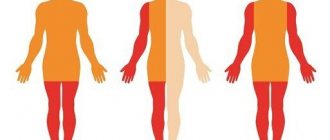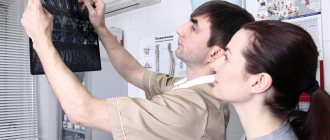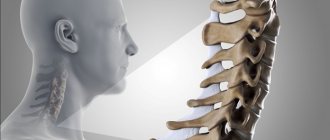Hypoesthesia of the limbs is a clinical symptom indicating that the conduction of impulses along sensory types of axons is impaired. Hypesthesia can develop as a concomitant disease with osteochondrosis of the spinal column, deforming osteoarthritis of large joints, lesions of the nerve plexuses, and tunnel syndromes. Without a pathological cause (disease), hypoesthesia of the upper and lower extremities does not develop. This is not an independent disease; therefore, for its successful treatment it is necessary to identify the pathology and deal with it.
What hypoesthesia is and what symptoms it gives is described in the article presented to your attention. The main types of nervous disorders and modern methods of effective and safe treatment are discussed here.
With hypoesthesia, sensitivity is impaired. It may be reduced, distorted or completely absent. The patient does not feel cold, heat, pain from injections, etc. Different parts of the body can be affected: scalp, face, lips, tongue, back, anterior abdominal wall. But more often the upper and lower extremities are affected, like gloves and socks. Those. the patient does not fully feel in the area covered by gloves or socks.
With physiological numbness, a short-term reaction is observed in response to being in an uncomfortable position, in which the blood supply to certain parts of the body is disrupted. Most often, the leg or arm on one side becomes numb. After a person changes his position, he experiences a strong tingling sensation, which indicates that the blood supply has been completely restored. Then the hypoesthesia goes away completely and without a trace.
If the feeling of numbness and lack of sensitivity lasts longer than 60 minutes, you should immediately seek medical help. Sometimes this is how the first signs of acute cerebrovascular accident appear. But most often this is a consequence of the development of serious pathologies of the musculoskeletal system. So, with an intervertebral hernia, hypoesthesia of the upper and lower extremities means that a person develops stenosis of the spinal canal due to prolapse of the protrusion of the nucleus pulposus. With compression of the spinal cord, sensitivity in the distal parts (hands and feet) is gradually lost.
The sooner medical assistance is provided, the higher the chances of complete restoration of innervation. Without seeing a doctor, a person risks remaining disabled over time.
In Moscow, you can make a free appointment with a neurologist at our manual therapy clinic. The doctor will conduct a full examination and identify the cause of the sensitivity disorder. Additional examinations will be recommended (as needed). After making an accurate diagnosis, the specialist will prescribe an individual course of treatment for you.
What causes hypoesthesia?
Now let’s look at what causes most often cause hypoesthesia in adults. This condition is a symptom of many diseases. Some of them can affect the central nervous system and cerebral structures of the brain. Thus, in some cases, hypoesthesia is the initial sign of a brain tumor or developing ischemic stroke. If you pay attention to this condition in time, you can avoid disability and fully restore your health.
Among the potential causes of hypoesthesia of the limbs are the following conditions:
- spasm and incomplete patency of the blood vessels of the brain (often develops as a complication of cervical osteochondrosis associated with posterior vertebral artery syndrome);
- damage to the radicular nerves due to osteochondrosis, protrusion and herniated intervertebral discs;
- tumors of the spinal cord, hard and soft tissues of the spinal column;
- Bechterew's disease (ankylosing spondylitis), systemic lupus erythematosus, scleroderma and other rheumatic processes;
- instability of the position of the vertebral bodies and their periodic displacement relative to each other with compression of the radicular nerves and their branches;
- diabetic angiopathy and neuropathy of the upper and lower extremities;
- spinal canal stenosis;
- spinal trauma (compression fracture, cracks, dislocation and subluxation of the vertebra, hematoma in the dural sac);
- serious infections affecting the spinal cord and brain (tick-borne encephalitis, tuberculosis, meningitis, polio);
- deficiency of certain vitamins (mainly group B) and minerals, which are conductors of nerve impulses, in the diet;
- toxic effects on the human body (taking certain medications, smoking, drinking alcoholic beverages, working in an environmentally unfavorable environment, etc.);
- iron deficiency with the development of anemia and the inability to transport sufficient oxygen to the distal limbs;
- cardiac vascular failure;
- vasculitis and other types of severe damage to the bloodstream (arteries and arterioles).
Identifying the real cause of hypoesthesia is the initial stage of treatment. If an accurate diagnosis is not established, then treating this condition as an independent disease will be useless. Sensory impairment will occur again and again until the cause of the pathology is eliminated.
Types and types of hypoesthesia
The division into types of hypoesthesia is based on several factors:
- localization (lower or upper limbs);
- symmetry of the lesion (unilateral or bilateral);
- cause (compression, trauma, ischemia, tumor, infection, endocrinology, etc.);
- damage to the type of nerve fiber;
- duration of the course (acute or chronic).
In most cases, there are mixed types of hypoesthesia, which develop against the background of the negative impact of various factors. For example, with a back injury, acute compression hypoesthesia may simultaneously develop with a gradually transforming state into a chronic sensitivity disorder. Next, we will consider in more detail the most common type of pathology.
Conductive hypoesthesia of the distal limbs according to the radicular type
Most patients develop hypoesthesia of the radicular type, which is associated with impaired conduction of nerve impulses against the background of compression at the level of the foramen in the vertebral body. This condition accompanies advanced cases of osteochondrosis. With it, dystrophic degenerative destruction of the fibrous ring of the intervertebral disc occurs. First, it becomes dehydrated and loses its elasticity, then it loses its physiological height. In this condition, the intervertebral disc loses its ability to provide protection to the radicular nerve emerging next to it.
Conductive hypoesthesia can affect not only the arms or legs. It is often localized in the lumbar region, face, groin, perineum, and anterior abdominal wall. Depending on which radicular nerve is affected, distal hypoesthesia may be accompanied by impaired motor function. In this case, in addition to hypoesthesia of the distal limbs, there is muscle weakness associated with impaired innervation and trophism of the underlying muscles.
Mental hypoesthesia
Mental hypoesthesia is a weakening of sensitivity up to its loss, i.e. anesthesia. The definition of “mental” indicates that the disorder is not associated with neurological pathology, conductive or central, nor is it associated with damage to the receptors of the corresponding sensory organs. Let us add one more important note to what has been said. In this fragment of the text, it is impossible not to touch upon the topic of the pathology of self-perception, that is, the loss of the ability to recognize certain sensations. It is quite difficult to distinguish between where there is a violation of the very process of formation of sensations, and where sensations are fully formed, but are not realized.
Moreover, both types of violations may well be combined with one another, and it is difficult to formulate any specific judgments here. Nevertheless, we will indicate two signs that allow, although not always, to make an appropriate distinction. Firstly, disturbances of the sensations themselves can be identified by objective research methods. For example, with the loss of pain sensitivity, the application of painful stimuli is not accompanied by the appearance of a sensation of pain. The loss of awareness of the feeling of pain is different in that the sensation of pain, as it turns out, is preserved to one degree or another. Secondly, the disturbance of sensations is often not noticed by the patient and is detected only during a special examination.
| | Our clinic accurately diagnoses such conditions. |
Often this disorder does not bother patients. In the case of a disorder of self-awareness, the patient will most often notice the fact of the disorder himself, and perhaps draw the doctor’s attention to it. In addition, such a disorder is often accompanied by a more or less pronounced reaction of suffering. In the following clinical illustrations of hypoesthesia, testimonies of patients exhibiting symptoms of impaired self-perception especially often appear.
A decrease in the intensity of sensations can occur in different analyzers and manifest itself in each of the above modalities. In accordance with this, we will indicate the symptoms of the disorder.
Mental hypalgesia and analgesia - reduction and loss of pain sensitivity. The term indolence is used less frequently. Loss of pain sensitivity, including persistent ones, is especially often detected in an acute psychotic state with symptoms of confusion, catatonia, delusions and hallucinations. The fact that the pain sensations in catatonic patients are preserved is evidenced by the vivid reaction of the pupils to pain - when painful stimulation is applied, the patients’ pupils dilate.
This symptom in catatonic patients was first described by O. Bumke (1903). Such patients often commit acts of self-harm and suicide with extensive self-injury to various organs, including internal ones, without any awareness of pain. Thus, the patient, on the orders of the “voices,” cut both of his legs “like sticks” without feeling any pain. Pain sensitivity is restored as the mental state improves. Awareness of pain is also lost in patients with severe depression, in a state of passion, when consciousness is stunned, in a hypnotic trance, in intoxication, or during meditation. The mechanisms of analgesia in this case are most likely heterogeneous. Thus, the loss of the feeling of pain during deafening of consciousness is possibly associated with the shutdown of higher levels of personality, in particular self-awareness, as well as a dysfunction of the cortical structures of pain.
Confusion of consciousness inevitably entails confusion of self-awareness, as is clearly seen in oneiroid, and, consequently, leads to a disturbance in the perception of various manifestations of the Self, including analgesia. In depression, awareness of pain is likely to be more affected. Pain sensitivity sometimes decreases due to depersonalization. Patients feel their own pain as if it belongs to someone else or is perceived somewhere far away and thus seems to lose its severity. Loss of superficial pain sensation (“quick pain”) occurs in patients with progressive paralysis, most likely due to damage to nerve cells and pain pathways.
Hysterical analgesia is explained by a selective focus of attention or, in the terminology of psychoanalysis, with the repression of the feeling of pain. This happens because hysterics benefit from disruption in one way or another. In any case, most doctors, following P. Janet and Z. Freud, still share such accusations of patients. During sleep, pain sensitivity often decreases - hypnoanalgesia. This is probably due to “sleepy inhibition” of nerve cells. A phenomenon such as audio analgesia—a decrease in pain sensitivity under the influence of loud sounds—has also been described. Audioanalgesia appears to be a consequence of reciprocal intermodal sensations. With tabes dorsalis, Abadi's symptom occurs - the absence of a pain response in response to compression of the heel tendon. Similar assumptions can be made for the following types of loss of sensitivity.
Mental anakusia and hypoacusia are loss (weakening) of the sensation of sound. Dulling of the acuity of perception of acoustic stimuli. It is especially common in depression. The sounds seem to patients to be weakened, indistinct, poorly modulated, coming as if from afar: “My ears feel stuffy, like there’s cotton in them, I don’t seem to hear enough, I can’t understand what they’re saying to me, sometimes I ask again.” With hysteria, functional deafness occurs, usually combined with loss of the ability to speak - surdomutism.
Mental anopsia and hypoopsia are loss (weakening) of photosensitivity. Depressed patients often report that bright lighting seems dim, dull, evening to them, everything is perceived as in a haze, through a veil, a veil, a curtain, as through a window on a rainy day, or as if the eyes were curtained, covered with a film. The contours of objects are not clearly perceived, they are seen as unclear, blurry, lacking clear outlines, fluctuating in the wrong light. At the same time, color perception also suffers. Colors seem faded, faded, pastel, shades of different colors are difficult to distinguish. With hysteria, functional amblyopia is observed - motivated blindness. The symptom of looking into the eyes is also characteristic: the patient looks directly into the eyes of the interlocutor, even if he changes his location.
Mental ageusia and hypogeusia are loss (dulling) of taste sensations. Described mainly in depression. Food seems tasteless, bland, and monotonous to patients: “It’s like you’re chewing grass or rubber. No matter what you eat, everything seems equally tasteless. If you don’t look at what’s on the table, it seems like you won’t be able to discern what kind of food it is... I don’t feel a sweet taste, the food seems bitter.” Ageusia can be partial, affecting only some submodal taste sensations. Objectively, taste sensitivity may not be impaired.
Mental anosmia and hyponosmia - loss (dulling) of olfactory sensations: “I don’t understand whether it smells like something or not... I can’t distinguish odors, like with a runny nose, it’s as if they’re not there at all... I don’t smell perfume... Food doesn’t seem to smell or smells somehow differently". Detailed questioning may reveal different shades of what patients describe as loss of smell. An objective test often does not reveal a violation of the sense of smell.
Mental anathia and hyponaphy - loss (dulling) of tactile sensations:
“The skin on my cheek is numb, my cheek feels like it’s made of wood, I touch it, but she feels almost nothing... The skin under the kneecaps seems to be frostbitten. I touch it, press it, but I don’t feel it... I don’t feel anything with my lips, it’s as if they’re not mine, as if they were glued... I wash myself in the morning, but I don’t feel the water with my hands, as if I’m rubbing with dry palms.” Areas of loss of sensitivity have different localization and configuration that do not coincide with the anatomical zones of innervation. In the Middle Ages in Europe, areas of skin anesthesia were considered “marks of the devil,” and such patients usually faced torture and the stake. If we consider such a disorder to be hysterical, then it is difficult to imagine what the “secondary benefit” could be here, supposedly characteristic of patients. In hysterical surdomutism, we add, tactile hypoesthesia of the skin of the ears and ear canals is simultaneously detected.
Mental apallesthesia and hypopallesthesia are loss (weakening) of vibration sensations. This is apparently indicated by the following reports from patients: “Everything inside froze, stopped... I don’t feel my heart beating, there seems to be no pulse... It’s like there’s nothing inside, there’s emptiness.”
Mental abathesthesia and hypobathesthesia - loss (weakening) of kinesthetic sensations: “My legs are like cotton wool, I don’t feel them well... My arms are numb, as if they were numb, as if I had been resting them... The movements are light, imperceptible, as if the joints are lubricated... I do everything with some incredible ease, effortlessly, my arms dangle as if on hinges.” Sometimes the perception of the position of body parts is disrupted: “I close my eyes and can’t understand how my arms lie, whether my legs are bent or extended, whether my fists are clenched or not... I don’t feel which way I turned my head, whether I’m sitting or lying.”
Mental abaresthesia and hypobaresthesia - loss (weakening) of sensations of pressure and weight: “I don’t feel the weight of the load... It seems to me that I can’t close my eyes and determine whether the bucket is full or empty... I can’t figure out whether I can handle this load or not... I seem to myself weightless... I seem to be so light, I’ll jump now and fly... My body seems to be as light as feathers. I’m afraid someone will sneeze or the wind will blow and I’ll be carried away... I squeeze my leg or arm, but I don’t feel it... They squeeze my arm with a tourniquet, but I don’t feel the pressure.”
Mental astatesthesia and hypostatesthesia - loss (weakening) of the static feeling: “The car accelerates, and I feel the acceleration only with my back... The plane falls into a hole, I only feel weightlessness, but there is no sensation of falling... It happened that you spin, stop and everything turns in the other direction. But now there is no such thing.”
Mental athermesthesia and hypothermesthesia - loss (weakening) of temperature sensitivity: “I can’t feel whether it’s hot or cold... I burned my hand and didn’t even feel it... I can’t feel with my hands whether the ice is cold... I don’t wear mittens or gloves, my hands don’t freeze... In winter, It’s frosty, I walk around without a hat and I don’t feel cold... I don’t feel the temperature. The thermometer says it’s about 40, but I don’t feel it at all.”
Back to contents
Hypoesthesia of the leg (hips, legs, feet)
In most cases, hypoesthesia of the leg occurs against the background of the development of lumbosacral osteochondrosis and its complications. Bilateral hip hypoesthesia is the first clinical sign of cauda equina compression. This may be a symptom of a coccyx injury or arthrosis of the sacrococcygeal joint. Unilateral damage is typical for compression of the radicular nerve in the L5-S1 space. With tunnel syndromes, hypoesthesia of the feet, sagging of the arches and the development of transverse, longitudinal or mixed flat feet may appear.
When hypoesthesia of the lower leg appears, it is important to exclude vascular pathologies, such as:
- varicose veins of the lower extremities with severe swelling of the lower third of the leg;
- atherosclerosis (the formation of cholesterol plaques primarily occurs in the large blood vessels of the lower limb);
- obliterating endarteritis (more often formed in men aged 30 to 45 years who smoke);
- diabetic angiopathy.
When the first signs of hypoesthesia of the lower extremities appear, you should consult a neurologist. This doctor will be able to determine the exact cause of the sensitivity disorder during the initial examination.
Hypesthesia of the hands (fingers and hands)
Hand hypoesthesia is a common symptom of the development of tunnel syndromes. If the carpal valve or carpal tunnel is damaged, hypoesthesia of the fingers occurs, and if the ulnar nerve is damaged, the entire hand on the affected side may become numb.
In addition to tunnel syndromes, hand hypoesthesia accompanies brachial plexitis or plexopathy. When any of the three branches extending from the brachial nerve plexus is compressed, sensory disturbances in the hand and forearm may occur. Then the loss of sensitivity spreads to the shoulder.
With hypoesthesia of the hands, it is important to begin differential diagnosis with a comprehensive examination of the condition of the cervical spine. There may be two pathological factors that have a negative impact on the process of innervation of the upper extremities:
- with osteochondrosis complicated by protrusion and disc herniation, pressure is exerted on the radicular nerve responsible for the innervation of the arm;
- With posterior vertebral artery syndrome, the blood supply to the brain structures responsible for conducting sensory impulses from the upper extremities is disrupted.
Therefore, it is necessary to conduct a comprehensive diagnosis. Depending on the identified pathology, an individual course of therapy is prescribed.
Sensory impairment
Conversion disorders
Initial appointment with a neurologist: 1850 rub.
- Convulsive and non-convulsive seizures
- Balance imbalance
- Weakness in the limbs
- Trembling. Jerking
- Sensory impairment
- Memory impairment
Impaired sensitivity of the hands and feet is most common in two manifestations: numbness (hypesthesia) and tingling (dysesthesia, parasthesia). Tingling and numbness refer to sensations that occur in a specific area of the skin surface. They are often combined with other sensations, such as chilliness, burning, and tightness. Treatment of body numbness should begin at the first symptoms. Treatment of sensitivity disorders is prescribed depending on the type of manifestation. Treatment of tingling in the hands, as well as treatment of tingling in the legs, also needs to begin as early as possible.
Impaired sensitivity of the fingers is a manifestation of disturbances in the passage of nerve impulses from the skin to the brain. This often happens when a nerve is compressed, a part of the body where the nerve passes near the surface of the skin, or in places of possible injury: wrist, foot, lower leg. Therefore, treatment of tingling fingers is one of the most popular services.
Numbness, tingling in the hands and other extremities and other sensory sensations may be symptoms of the following diseases:
- Circulatory disorders of the extremities
- Migraine
- Diabetes
- Lack of vitamins, microelements, alcohol abuse
- Transient ischemic attacks involving one arm, leg or any part of the body, all extremities
- Pinched nerve in its natural location: wrist, elbow, groin, ankle
- Rheumatoid arthritis, other diseases in which the nerves are affected due to joint deformation
- Multiple sclerosis
- Hereditary diseases.
Based on this, we can conclude that the causes and treatment of hypoesthesia are prescribed individually to each client.
Polyneuropathy is a common sensory disorder characterized by multiple lesions of peripheral nerves. Such a lesion can develop due to diseases of internal organs, in some cases of a hereditary nature.
It must be remembered that impaired sensation in the legs and arms can be symptoms not only of polyneuropathy disorder, but also of a number of other diseases.
- Transient ischemic attacks involving one leg, arm, body part, or all extremities at once
- Compression of nerves in the arm, leg. So-called tunnel syndromes
- Syringomyelia
- Multiple sclerosis
That is why treatment of skin numbness , as well as treatment of leg numbness, is based on identifying the cause and suppressing it.
Our clinic successfully performs
- treatment of hand numbness,
- treatment of numbness of feet,
- treatment of numbness in fingers,
- treatment of numbness of the legs and dysesthesia of the hands.
Achieving high efficiency is the key to a systematic approach and complete diagnostics.











